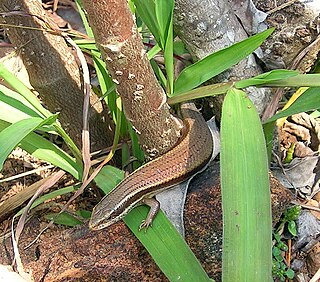
Skinks are lizards belonging to the family Scincidae, a family in the infraorder Scincomorpha. With more than 1,500 described species across 100 different taxonomic genera, the family Scincidae is one of the most diverse families of lizards. Skinks are characterized by their smaller legs in comparison to typical lizards and are found in different habitats except arctic and subarctic regions.

Emoia is a genus of skinks, lizards in the subfamily Eugongylinae. The genus Emoia belongs to a group of genera mainly from the southwestern Pacific-Australian region.

Lamprolepis is a genus of lizards, known commonly as emerald skinks, in the subfamily Lygosominae of the family Scincidae. Lygosoma is its closest genetic relative.

Mochlus is a genus of skinks, lizards in the family Scincidae. The genus is endemic to Africa.
Tropidophorus is a genus of semiaquatic lizards in the skink family (Scincidae), found in Indochina, Borneo, Sulawesi, and the Philippines. They are sometimes known as water skinks or waterside skinks.
Edward Harrison Taylor was an American herpetologist from Missouri.

Blue-tongued skinks comprise the Australasian genus Tiliqua, which contains some of the largest members of the skink family (Scincidae). They are commonly called blue-tongued lizards or simply blue-tongues or blueys in Australia or panana in Indonesia. As suggested by these common names, a prominent characteristic of the genus is a large blue tongue that can be bared as bluff-warning to potential enemies. Their tongue can also deform itself and produce a thick mucus in order to catch prey. They are relatively shy in comparison with other lizards, and also significantly slower due to their shorter legs.
Green tree skink can refer to several skink species:
Carinascincus palfreymani, known commonly as the Pedra Branca skink, as well as the Palfreyman's window-eyed skink, the Pedra Branca cool-skink, or the red-throated skink, is a species of skink in the family Scincidae. The species is endemic to Australia, and is restricted to the windswept Pedra Branca, an island off southern Tasmania of only 2.5 ha, where it is dependent on the seabird colonies. It is the only lizard species found on the island.

The blue-wattled bulbul is a species of songbird in the bulbul family of passerine birds. The specific epithet commemorates Dutch explorer Anton Willem Nieuwenhuis. The bird is endemic to the islands of Borneo and Sumatra. Its natural habitat is subtropical or tropical moist lowland forests.
Nieuwenhuis or Nieuwenhuys is a Dutch surname cognate to English Newhouse and German Neuhaus. A great number of variant forms exist. "Nieuwen" can be replaced by Nei, Neij, Nein, Nie, Nien, Nieuw, Nieuwe, Niewen, Nij, Nijen, Nou and Nuwen. "Huis" can be Hues, Huijs, and Huys. Declensions may end with -se, -sen, -ze, and -zen and the name can start with van ("from"). Notable people with this name include:

Lygosominae is the largest subfamily of skinks in the family Scincidae. The subfamily can be divided into a number of genus groups. If the rarely used taxonomic rank of infrafamily is employed, the genus groups would be designated as such, but such a move would require a formal description according to the ICZN standards.

Carinascincus metallicus, the metallic cool-skink or metallic skink is a species of skink in the family Scincidae. It is endemic to Australia, found in southern Victoria, as well as in Tasmania where it is the most widespread and common lizard, occurring on many offshore islands in Bass Strait as well as the mainland. It gives birth to live young. It is highly variable in colour and pattern, and may be a complex of closely related species.

Anton Willem Nieuwenhuis was a Dutch explorer and physician who travelled extensively in central Borneo in the 1890s, recording valuable ethnographic information about the Dayak people and making biological collections.
Emerald skink may refer to:
Tree skink is primarily the common name of members of the skink genus Dasia.
Theodorus Willem van Lidth de Jeude was a Dutch zoologist and herpetologist. He is not to be confused with his grandfather's brother, the Dutch veterinarian and zoologist Theodoor Gerard van Lidth de Jeude (1788–1863).
The white-spotted tree skink is a species of skink known only from West Java, Indonesia. It is an uncommon arboreal species.
Dasia vyneri, also known commonly as Shelford's skink and Vyner's tree skink, is a species of lizard in the family Scincidae. The species is native to Southeast Asia.









